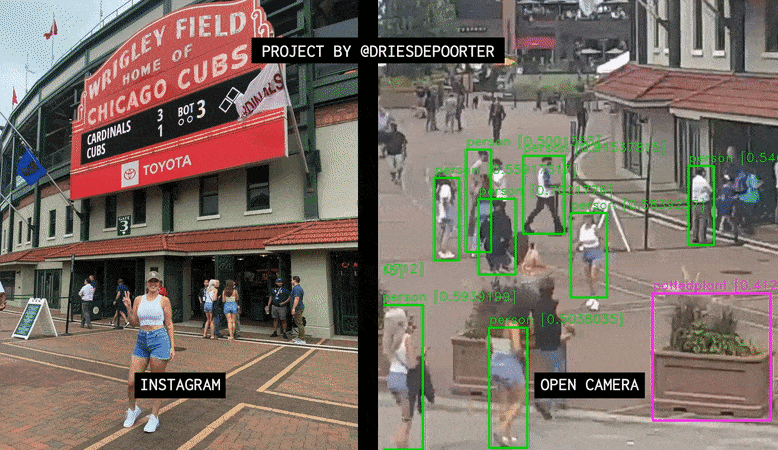
“Spawning is building tools for artists ownership of their training data, allowing them to opt into or opt out of the training of large AI models, set permissions on how their style and likeness is used, and offer their own models to the public”.

“Spawning is building tools for artists ownership of their training data, allowing them to opt into or opt out of the training of large AI models, set permissions on how their style and likeness is used, and offer their own models to the public”.

Dries Depoorter‘s “The Follower” project combines AI, open access cameras, and influencers to show behind the scenes of viral shots—without them knowing.
[via]
I don’t know how it’s possible that I didn’t come across this masterpiece before.
Passage a l’acte, by Martin Arnold (1993) “makes a simple breakfast scene from To Kill a Mockingbird look like a surrealist nightmare“.
“A 13-part television series covering aspects of the Internet in 1996 to introduce to a general audience. Called “Life on the Internet”, the series was hosted by Scott Simon, sponsored by Sun Microsystems, and covers the state of online life at the time”.

“this is not a hall of shame. the intent is to awaken you to many of the peculiarities and weirdness of computers. hopefully, after reading these articles, you will have learned a lot and will embrace chaos.”
“The Happiness Box theory posits that sufficiently advanced civilizations don’t swarm out into the universe, they implode into virtual worlds of their own making. If you could gain the ability to upload consciousness into simulated realities that are functionally indistinguishable from physical reality, why would you bother to climb into a physical spaceship to outwardly explore?”
[via]
Amazing sculpture, amazing performance, great video.
According to this research, in David Glowacki‘s VR experience, Isness-D “participants can partake in an experience called energetic coalescence: they gather in the same spot in the virtual-reality landscape to overlap their diffuse bodies, making it impossible to tell where each person begins and ends. The resulting sense of deep connectedness and ego attenuation mirrors feelings commonly brought about by a psychedelic experience.”
The study, involving 75 subjects, showed that Isness-D offers an experience near indistinguishable from 20 milligrams of psilocybin or 200 micrograms of LSD.
[via]

“The Fiberglass Mold Graveyard of Sparta, Wisconsin is a zoo full of discarded animal-creature-and people-shaped molds. This field of plastic carcasses lies behind the FAST building, aka the Fiberglass Animals, Shapes, and Trademarks workshop. Both spooky and wondrous looking, this field of gigantic molds, left behind from various projects, has become an art installation in itself.”
[via]

W. David Marx and Roni Xu used DALL-e to generate imagery of the absurd cuisine from Filippo Tommaso Marinetti’s 1932 tome The Futurist Cookbook. The results are fascinating.
The Lore Zone. A very interesting online research on “Memes → Memories → Micro-Mythologies”
My new favourite fan theory is the one that says that Snowpiercer is a sequel to Willy Wonka.
American Psycho, But With The TikTok Girl Voice.
[via]
A very interesting and entertaining video on his Majesty mr. Buster Keaton.

“For over a decade, a Chinese woman known as “Zhemao” created a massive, fantastical, and largely fictional alternate history of late Medieval Russia on Chinese Wikipedia, writing millions of words about entirely made-up political figures, massive (and fake) silver mines, and pivotal battles that never actually happened. She even went so far as to concoct details about things like currency and eating utensils.”
[more here]

“Jacob Hurwitz-Goodman traces the significance of Facebook’s Newsfeed launch, from the initial rage it engendered to its precipitation of the algorithm-dominated status quo of current-day digital media. Prior to Newsfeed, early internet users had static profiles and had to consciously click and search for things on the site. Upon its launch, the blueprint for media inexorably changed: we were no longer explorers, searchers, discoverers—our very experience of time collapsed into an ever-shifting present; we became passive consumers of a digital feed algorithmically curated to our every trivial fancy. “
[streaming on DIS]
In this video Philip Dyer compares three AI image generators: Dall.E Mini, Midjourney and Dall.E 2.
“The Subject Changes is a poetic live simulation of a capricious character, endlessly shape-shifting while negotiating his/her ambiguous world. The character sets out on an indefinite dérive – a frantic exploration – where fragile relationships with the world-cum-stage and its occupants are established or broken down. His/her state is ornately reflected in a constantly mutating attire, a fluctuating embodied masquerade — the virtual body as an encoded aesthetic artefact.”
Created by Vienna based Depart (Leonhard Lass and Gregor Ladenhauf).
Essai d’ouverture is a 1988 short French film by Luc Moullet. It’s about a man and his many bizarre approaches to opening a Coca-Cola bottle.
[via]

Heaven banning is not real, nor are the articles that people are sharing about it. But it is a fascinating concept nonetheless, that can be read as an extension of the Dead Internet Theory. According to some sources, it is just a resurrected joke post from HackerNews.

In his latest work “Amends”, artist Kyle McDonald is auctioning three sculptures – from which the proceeds will pay to mitigate the historical emissions of three major art NFT marketplaces. The sculptures are both digital renders and physical handcrafted glass blocks, each filled with a material used for carbon removal and prevention. But they will only go on sale when Ethereum (finally? actually?) transitions away from proof-of-work. And the sculptures will be shipped to the owners of the NFTs—if they burn their NFT.
McDonald says: “The science shows that even if we end all emissions today, we still need to remove hundreds of billions of tons of historical greenhouse gases from the atmosphere and ocean. In tech the motto is ‘move fast and break things’, but those broken pieces are haunting us. Changing things going forward isn’t enough. This work represents a major opportunity to take responsibility for a small portion of our impact on the environment.”
I recently got an invitation to test the MidJourney beta, which is an amazing new AI app that generates images from text inputs. I’ve been playing with it for a while but I also spent hours just watching other people using it in a dedicated Discord server. It was a very funny and interesting experience and I got some amazing visual results, especially when I came up with the idea of feeding the algorithm a literary input instead of a merely descriptive sentence. Here are some images the app produced me based on some famous books incipits.
imagine/ The sky above the port was the color of television, tuned to a dead channel. – William Gibson, Neuromancer, 1984

imagine/ It was a bright cold day in April, and the clocks were striking thirteen. — George Orwell, 1984, 1949

imagine/ “Psychics can see the color of time it’s blue. – Ronald Sukenick, Blown Away, 1986

imagine/ Once upon a time , there was a woman who discovered she had turned into the wrong person. – Anne Tyler, Back When We Were Grownups, 2001
